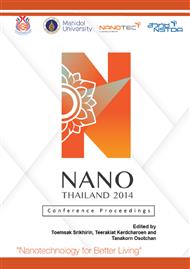p.16
p.20
p.25
p.35
p.39
p.43
p.49
p.53
p.60
Growth and Characterizations of Tin-Doped on Nickel-Phthalocyanine as a Novel Nanomaterial
Abstract:
Tin-doped nickel phthalocyanine thin films (Sn-doped NiPc) were deposited by thermal co-evaporation method. Doping concentration of tin in NiPc was controlled via different deposition rates between metal dopent and host organic material. Properties of the thin films doped by tin in the range of 3 to 15% were characterized by atomic force microscopy (AFM), field emission scanning electron microscopy (FESEM), UV-Visible spectroscopy and X-ray photoelectron spectroscopy (XPS). Furthermore, electrical properties of Al/Sn-doped-NiPc/ITO devices i.e. charge carrier concentration and carrier mobility were characterized by current-voltage and capacitance-voltage measurements. Microscopic results show clear evidence of the morphological transition from granular structure in undoped-film to rod-liked structure in the films doped more than 5%. Moreover, surface grain size exhibits the tendency to decrease with the increase of doping concentration. Optical properties reveal that the packing of NiPc molecules in all doping conditions is the combination of α-phase (majority) and β-phase (minority). However, evolution of β-phase NiPc is observed with the increase of doping concentration. Photoelectron analyses indicate shift of binding energy in both Ni2p and Sn3d levels corresponding to charge transfer between nickel-core and tin dopant. In addition, the electrical properties show the enhancement of the film’s conductivity due to the increase of charge carrier concentration with the higher Sn-doping level.
Info:
Periodical:
Pages:
39-42
Citation:
Online since:
December 2015
Price:
Сopyright:
© 2016 Trans Tech Publications Ltd. All Rights Reserved
Share:
Citation:


